
The Restionaceae, also called restiads and restios, are a family of flowering plants native to the Southern Hemisphere; they vary from a few centimeters to 3 meters in height. Following the APG IV (2016): the family now includes the former families Anarthriaceae, Centrolepidaceae and Lyginiaceae, and as such includes 51 genera with 572 known species. Based on evidence from fossil pollen, the Restionaceae likely originated more than 65 million years ago during the Late Cretaceous period, when the southern continents were still part of Gondwana.

Charles Gaudichaud-Beaupré was a French botanist.
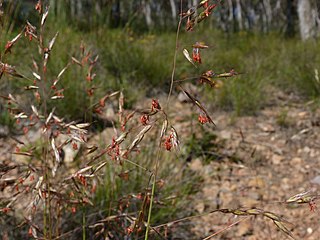
Rytidosperma pallidum, commonly known as red-anther wallaby grass, is an Australian species of tussock grass found in Victoria, New South Wales and the Australian Capital Territory. The grass has flowers in December, and the flowers have a prominent red anther, after which it is commonly named.
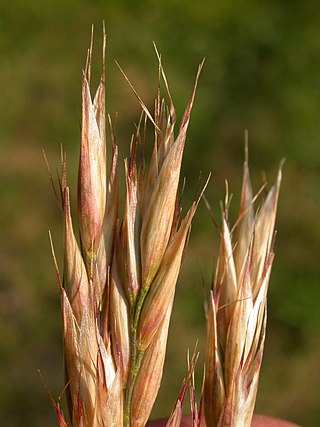
Danthonia is a genus of Eurasian, North African, and American plants in the grass family. Members of this genus are sometimes referred to as oatgrass, but that common name is not restricted to this genus. Other common names include heathgrass and wallaby grass. Australian species have since been reclassified into the genus Rytidosperma.

Adriana is a genus of shrubs in the family Euphorbiaceae, first described as a genus in 1825. The entire genus is endemic to Australia.
- Adriana quadripartita(Labill.) Mull.Arg. - South Australia, Victoria, southern Western Australia
- Adriana tomentosaGaudich.- All mainland states
- Adriana urticoides(A.Cunn.) Guymer ex P.I.Forst. - Northern Territory plus all states except Tasmania
Austrostipa crinita is a species of grass that grows in coastal parts of midwest Western Australia.

Amphibromus is a genus of grasses in the family Poaceae. Most are known as swamp wallaby grass. Most are endemic to Australia. One can also be found in New Zealand and there are two species in South America.

Rytidosperma is a genus of plants in the grass family. Most of the species occur in Australasia, with a few in insular Southeast Asia, southern South America, and certain islands of the Pacific. Several are known by the general common name wallaby grass.

Thelionema caespitosum, the tufted lily or tufted blue-lily, is a species of perennial herb, native to Australia. The lily-like flowers are blue, light blue, pale yellow or white and have yellow stamens.

Rytidosperma setaceum, known by various common names including small-flowered wallaby-grass, mulga- or bristly wallaby-grass, is a species of grass native to Australia. Originally described by Robert Brown under the name Danthonia setacea, it was transferred into Austrodanthonia by Hans Peter Linder in 1993 and finally Rytidosperma in 2011.

Synemon theresa, the cryptic sun-moth, is a species of day-flying moth of the family Castniidae. It was described by Edward Doubleday in 1846. It has a wingspan of 26-40mm, and is mostly grey-brown with orange hindwings. Native to Australia, this species is extinct in Victoria, and is now only known from a relatively small area of South Australia near Adelaide. It uses Themeda triandra and Rytidopserma spp. as larval food plants. Adults can be found from November to February. They only live for a few days, as they do not have a feeding proboscis. Despite becoming extinct over much of its former range, the cryptic sun-moth is not listed as a threatened species in South Australia.
Wallaby grass is a common name for several grasses native to Australia and may refer to:
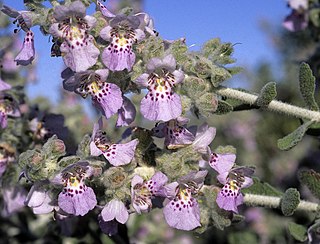
Quoya is a genus of flowering plants in family Lamiaceae and is endemic to Western Australia. Plants in this genus are shrubs with five petals joined to form a tube-shaped flower with four stamens of unequal lengths.

Quoya cuneata is a flowering plant in the mint family Lamiaceae and is endemic to the south-west of Western Australia. It is a spreading shrub with its branches and leaves covered with a layer of woolly, pale white or brownish hairs. The flowers are blue at first but become white with purple spots inside the petal tube.

Rytidosperma tenuius, or purplish wallaby grass, is an Australian species of wallaby grass found in south eastern Australia, usually on clay or sandy soils in the drier eucalyptus woodlands. The grass is perennial, and it may grow up to 1.2 m tall. It is native to the Australian states of Queensland, New South Wales, Victoria, South Australia and Tasmania, and it has been introduced to New Zealand. The inflorescences have a characteristic reddish colouration, and the attractive purplish bracts of young flowers can also aid in identification. The specific epithet tenuius is derived from the Latin for thin.
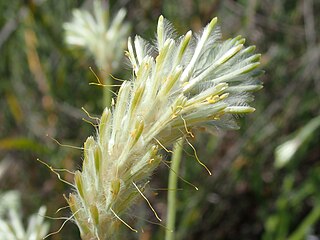
Ptilotus polystachyus is an herb in the Amaranthaceae family.

Ptilotus divaricatus is a shrub in the Amaranthaceae family.

Adriana tomentosa is a species of plant in the Euphorbiaceae family and is endemic to mainland Australia.

Schoenia cassiniana is a species of plant in the tribe Gnaphalieae within the family Asteraceae, native to Western Australia, South Australia and the Northern Territory. It was first described in 1829 by Charles Gaudichaud-Beaupré as Helichrysum cassinianum, but was transferred to the genus Schoenia in 1845 by Joachim Steetz.
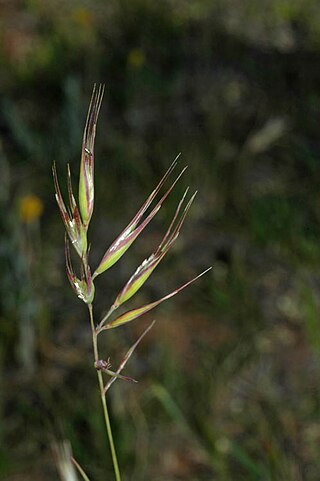
Rytidosperma erianthum, the hill wallaby grass, is a perennial species of grass found in south eastern Australia. Usually found in drier areas in a variety of habitats. The habit is somewhat variable, erect and densely tufted. The grass may grow up to 0.7 m tall.

















